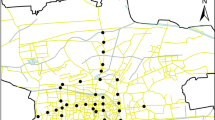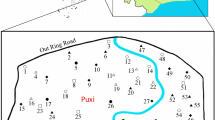Abstract
To better assess and understand potential health risk of urban residents exposed to urban street dust, the total concentration, sources, and distribution of 16 polycyclic aromatic hydrocarbons (PAHs) in 87 urban street dust samples from Tianjin as a Chinese megacity that has undergone rapid urbanization were investigated. In the meantime, potential sources of PAHs were identified using the principal component analysis (PCA), and the risk of residents’ exposure to PAHs via urban street dust was calculated using the Incremental Lifetime Cancer Risk (ILCR) model. The results showed that the total PAHs (∑PAHs) in urban street dust from Tianjin ranged from 538 μg kg−1 to 34.3 mg kg−1, averaging 7.99 mg kg−1. According to PCA, the two to three- and four to six-ring PAHs contributed 10.3 and 89.7 % of ∑PAHs, respectively. The ratio of the sum of major combustion specific compounds (ΣCOMB) / ∑PAHs varied from 0.57 to 0.79, averaging 0.64. The ratio of Ant/(Ant + Phe) varied from 0.05 to 0.41, averaging 0.10; Fla/(Fla + Pyr) from 0.40 to 0.68, averaging 0.60; BaA/(BaA + Chry) from 0.29 to 0.51, averaging 0.38; and IcdP/(IcdP + BghiP) from 0.07 to 0.37, averaging 0.22. The biomass combustion, coal combustion, and traffic emission were the main sources of PAHs in urban street dust with the similar proportion. According to the ILCR model, the total cancer risk for children and adults was up to 2.55 × 10−5 and 9.33 × 10−5, respectively.




Similar content being viewed by others
References
Bartoš T, Čupr P, Klánová J, Holoubek I (2009) Which compounds contribute most to elevated airborne exposure and corresponding health risks in the Western Balkans? Environ Int 35:1066–1071
Chen SC, Liao CM (2006) Health risk assessment on human exposed to environmental polycyclic aromatic hydrocarbons pollution sources. Sci Total Environ 366:112–123
Chen LG, Ran Y, Xing BS, Mai BX, He JH, Wei XG, Fu JM, Sheng GY (2005) Concents and sources of polycyclic aromatic hydrocarbons and organochlorine pesticides in vegetables soils of Guangzhou, China. Chemosphere 60:879–890
Choi SD, Ghim YS, Lee JY, Kim JY, Kim YP (2012) Factors affecting the level and pattern of polycyclic aromatic hydrocarbons (PAHs) at Gosan, Korea during a dust period. J Hazard Mater 227–228:79–87
Dong TTT, Lee BK (2009) Characteristics, toxicity, and source apportionment of polycylic aromatic hydrocarbons (PAHs) in road dust of Ulsan, Korea. Chemosphere 74:1245–1253
Dvorská A, Lammel G, Klánová J (2011) Use of diagnostic ratios for studying source apportionment and reactivity of ambient polycyclic aromatic hydrocarbons over Central Europe. Atmos Environ 45:420–427
Dvorská A, Komprdová K, Lammel G, Klánová J, Plachá H (2012) Polycyclic aromatic hydrocarbons in background air in central Europe—seasonal levels and limitations for source apportionment. Atmos Environ 46:147–154
Eom IC, Rast C, Veber AW, Vasseur P (2007) Ecotoxicity of a polycyclic aromatic hydrocarbon(PAH)- contaminated soil. Ecotoxicol Environ Saf 67:190–205
Finlayso-Pitts BJ, Pitts JJN (1997) Troposperic air pollution ozone, airbome toxics, polycyclic aromatic hydrocarbons and particles. Science 276:1045–1051
Grote M, Schüürmann G, Altenburger R (2005) Modeling photoinduced algal toxicity of polycyclic aromatic hydrocarbons. Environ Sci Technol 39:4141–4149
Han B, Bai ZP, Guo GH, Wang F, Li F, Liu QX, Ji YQ, Li X, Hu YD (2009) Characterization of PM10 fraction of road dust for polycyclic aromatic hydrocarbons (PAHs) from Anshan, China. J Hazard Mater 170:934–940
Harrison RM, Smith DJT, Luhana L (1996) Source apportionment of atmospheric polycyclic aromatic hydrocarbons collected from an urban location in Birmingham, UK. Environ Sci Technol 30:625–632
Hassanien MA, Abdel-Latif NM (2008) Polycyclic aromatic hydrocarbons in road dust over Greater Cairo, Egypt. J Hazard Mater 151:247–254
Hwang HM, Wade TL, Sericano JL (2003) Concentrations and source characterization of polycyclic aromatic hydrocarbons in pine needles from Korea, Mexico, and United States. Atmos Environ 37:2259–2267
Jiao WT, Lu YL, Li J, Han JY, Wang TY, Luo W, Shi YJ, Wang G (2009) Identification of sources of elevated concentrations of polycyclic aromatic hydrocarbons in an industrial area in Tianjin, China. Environ Monit Assess 158:581–592
Jiries A (2003) Vehicular contamination of dust in Amman, Jordan. Environmentalist 23:205–210
Joop V (2007) Urban soils—an emerging problem? J Soils Sediments 7:63
Knafla A, Phillipps KA, Brecher RW, Petrovic S, Richardson M (2006) Development of a dermal cancer slope factor for benzo[a]pyrene. Regul Toxicol Pharmacol 45:159–168
Larsen RK, Baker JE III (2003) Source apportionment of polycyclic aromatic hydrocarbons in the urban atmosphere: a comparison of three methods. Environ Sci Technol 37:1873–1881
Lee BK, Dong TTT (2011) Toxicity and source assignment of polycyclic aromatic hydrocarbons in road dust from urban resident and industrial areas in a typical industrial city in Korea. Journal of Material Cycles and Waste Management 13:34–42
Li XH, Ma LL, Liu XF, Fu S, Cheng HX, Xu XB (2006) Polycyclic aromatic hydrocarbon in urban soils from Beijing, China. J Environ Sci 18:944–950
Liao CM, Chiang KC (2006) Probabilistic assessment for personal exposure to carcinogenic polycyclic aromatic hydrocarbons in Taiwanese temples. Chemosphere 63:1610–1619
Liu M, Cheng SB, Ouyang DN, Hou LJ, Gao L, Wang LL, Xie YS, Yang Y, Xu SY (2007) Characterization, identification of road dust PAHs in Central Shanghai Areas, China. Atmos Environ 41:8785–8795
Liu SD, Xia XH, Yang LY, Shen MH, Liu RM (2010) Polycyclic aromatic hydrocarbons in urban soils of different land uses in Beijing, China: distribution, sources and their correlation with the city’s urbanization history. J Hazard Mater 177:1085–92
Lorenzi D, Entwistle JA, Cave M, Dean JR (2011) Determination of polycyclic aromatic hydrocarbons in urban street dust: implication for human health. Chemosphere 83:970–977
Lu H, Zhu L, Chen S (2008) Pollution level phase distribution and health risk of polycyclic aromatic hydrocarbons in indoor air at public places of Hangzhou, China. Environ Pollut 152:569–575
Luo XJ, Chen SJ, Mai BX, Sheng GY, Fu JM, Zeng EY (2008) Distribution, source apportionment, and transport of PAHs in sediments from the Pearl River Delta and the Northern South China Sea. Arch Environ Contam Toxicol 55:11–20
Lv JG, Shi RG, Cai YM, Liu Y (2010) Assessment of polycyclic aromatic hydrocarbons (PAHs) pollution in soil of suburban areas in Tianjin, China. Bull Environ Contam Toxicol 85:5–9
Maertens RM, Yang XF, Zhu JP, Gagne RW, Douglas GR, White PA (2008) Mutagenic and carcinogenic hazards of settled house dust I: polycyclic aromatic hydrocarbon content and excess lifetime cancer risk from preschool exposure. Environ Sci Technol 42(5):1747–1753
Maliszewska-Kordybach B (1996) Polycyclic aromatic hydrocarbons in agricultural soils in Poland: preliminary proposals for criteria to evaluate the level of soil contamination. Appl Geochem 11:121–127
Maselet P, Mouvier G, Nikolaou K (1986) Relative decay index and sources of polycyclic aromatic hydrocarbons. Atmos Environ 20:439–446
Mielke HW, Gonzales CR, Smith MK, Mielke PW (1991) The urban environment and children’s health: soil as an integrator of lead, zinc and cadmium in New Orleans, Louisiana, USA. Environ Res 81:117–129
Nisbet ICT, LaGoy PK (1992) Toxic equivalency factors (TEFs) for polycyclic aromatic hydrocarbons (PAHs). Regul Toxicol Pharmacol 16:290–300
Ounnas F, Jurjanz S, Dziurla MA, Guiavarc’h Y, Feidt C, Rychen G (2009) Relative bioavailability of soil-bound polycyclic aromatic hydrocarbons in goats. Chemosphere 77:115–122
Peng C, Chen WP, Liao XL, Wang ME, Ouyang ZY, Jiao WT, Bai Y (2011) Polycyclic aromatic hydrocarbons in urban soils of Beijing: status, sources, distribution and potential risk. Environ Pollut 159:802–808
Pu XZ, Lee LS, Galinsky RE, Carlson GP (2004) Evaluation of a rat model versus a physiologically based extraction test for assessing phenanthrene bioavailability from soils. Toxicol Sci 79:10–17
Schooten FJ, Moonen EJC, Wal L, Levels P, Kleinjans JCS (1997) Determination of polycyclic aromatic hydrocarbons (PAH) and their metabolites in blood, feces, and urine of rats orally exposed to PAH-contaminated soils. Arch Environ Contam Toxicol 33:317–322
Tobiszewski M, Namieśnik J (2012) PAH diagnostic ratios for the identification of pollution emission sources. Environ Pollut 162:110–119
US EPA (1991) Risk assessment guidance for superfund, part B (calculation of risk-based preliminary remediation goals) Washington, D. C. EPA/540/R-92/003
US EPA (1994) Integrated Risk Information System. “Benzo[a]pyrene (BaP)(CASRN 50-32-8)” from http://www.epa.gov/iris/subst/0136.htm. Accessed 8 Oct 2012
US EPA (2002) Supplemental guidance for developing soil screening levels for superfund sites. OSWER; 2002 [9355.4-24]
Wang Z, Chen JW, Qiao XL, Yang P, Tian FL, Huang LP (2007) Distribution and sources of polycyclic aromatic hydrocarbons from urban to rural soils: a case study in Dalian, China. Chemosphere 68:965–971
Wang W, Huang MJ, Kang Y, Wang HS, Leung AOW, Cheung KC, Wang MH (2011) Polycyclic aromatic hydrocarbons (PAHs) in urban surface dust of Guangzhou, China: status, sources and human health risk assessment. Sci Total Environ 409:4519–4527
Wilcke W (2007) Global patterns of polycyclic aromatic hydrocarbons (PAHs) in soil. Geoderma 141:157–166
Yu XZ, Gao Y, Wu SC, Zhang HB, Cheung KC, Wong MH (2006) Distribution of polycyclic aromatic hydrocarbons in soils at Guiyu area of China affected by recycling of electronic waste using primitive technologies. Chemosphere 65:1500–1509
Yunker MB, Macdonald RW, Vingarzan R, Mitchell RH, Goyette D, Sylvestre S (2002) PAHs in the Fraser River basin: a critical appraisal of PAH ratios as indicators of PAH source and composition. Org Geochem 33:489–515
Zakaria MP, Takada H, Tsutsumi S, Ohno K, Yamada J, Kouno E, Kumata H (2002) Distribution of polycyclic aromatic hydrocarbons (PAHs) in rivers and estuaries in Malaysia: a widespread input of petrogenic PAHs. Environ Sci Technol 36:1907–1918
Zhang ZL, Huang J, Yu G, Hong HS (2004) Occurrence of PAHs, PCBs and organochlorine pesticides in the Tonghui River of Beijing, China. Environ Pollut 130:249–261
Zhou QX (2005) Health soil science: soil health quality and safety of agricultural products (in Chinese). Science Press, Beijing, China
Zhou QX, Kong FX, Zhu L (2004) Ecotoxicology (in Chinese). Science Press, Beijing, China
Acknowledgments
We gratefully acknowledge that this work was financially supported by the National Natural Science Foundation of China as a key project (grant no. 21037002) and the National Key Basic Research Program (973) of China (grant no. 2011CB503802).
Author information
Authors and Affiliations
Corresponding author
Additional information
Responsible editor: Philippe Garrigues
Electronic supplementary material
Below is the link to the electronic supplementary material.
ESM 1
(PDF 183 kb)
Rights and permissions
About this article
Cite this article
Yu, B., Xie, X., Ma, L.Q. et al. Source, distribution, and health risk assessment of polycyclic aromatic hydrocarbons in urban street dust from Tianjin, China. Environ Sci Pollut Res 21, 2817–2825 (2014). https://doi.org/10.1007/s11356-013-2190-z
Received:
Accepted:
Published:
Issue Date:
DOI: https://doi.org/10.1007/s11356-013-2190-z




